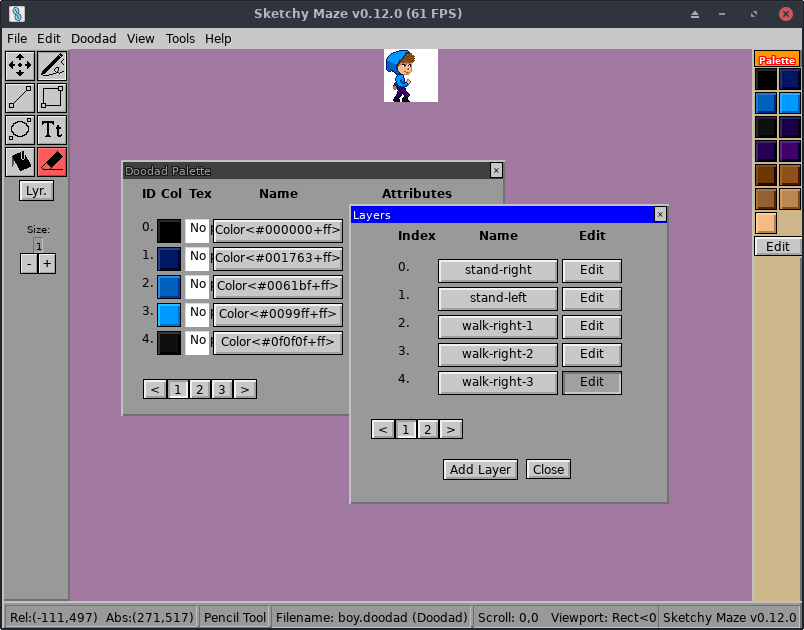4.4 KiB
Creating Custom Doodads
Sketchy Maze is designed to be modder friendly and provides tools to help you create your own custom doodads to use in your levels.
You can draw the sprites for the doodad either in-game or using an external image editor. Then, you can program their behavior using JavaScript to make them "do" stuff in-game and interact with the player and other doodads.
- Drawing your Doodad's Sprites
- Program its Behavior
In-game Doodad Editor
The in-game level editor can be used to create custom doodads. As of
Sketchy Maze v0.8.0, doodads can be authored entirely in-game without
needing to use the doodad command-line tool.
See Drawing Doodads for details.
Using external editors
You may find it more comfortable to draw your doodads in an external
image editor. All of the game's built-in doodads were drawn in The GIMP.
The doodad command-line tool that ships with the game is able to convert
a series of PNG images into a doodad, attach a JavaScript, set tags, and
so on.
See External Editors for Doodads
Example Doodads
There are some example custom doodads you can check out at https://code.sketchymaze.com/declassified/doodads. There you will find example custom doodads to make your own player characters, Warp Doors, and more.
Naming Convention
It is strongly encouraged that you name your custom doodad files with a prefix or something to namespace them apart from the built-in doodads.
For example: if you made a custom doodad named "door-red.doodad" it would actually conflict with the built-in doodad of the same name, and your custom doodad would take priority over the built-in one.
By prefixing your custom doodad filenames with your initials or name, you will minimize the likelihood that your doodad conflicts with a built-in from a future game release or with custom doodads made by other players than yourself.
Future versions of the game will likely prevent saving a new doodad with the same filename of a built-in one.
Categories
The in-game Doodad Dropper window of the level editor shows a categorical view of doodads: Objects, Doors, Gizmos, Creatures, and All.
Categories are managed by setting custom tags on your .doodad file, which can be done by the doodad tool like so:
doodad edit-doodad --tag "category=objects" example.doodad
The "category" tag should hold a lowercase value. Only supported categories are recognized, which include: objects, doors, gizmos, creatures.
A doodad can appear under multiple categories by joining them with a comma:
doodad edit-doodad --tag "category=doors,gizmos" example.doodad
Every doodad also appears in the "All" tab. In the future, custom tags will be editable using in-game UI when creating a custom doodad.
Profile Directory
Custom doodads and levels will go in your Profile Directory, into folders named "doodads" and "levels" respectively.
To share your custom doodads with others, you can copy the .doodad files out
of your doodads folder. To install doodads made by others, place their .doodad
files into your doodads folder, and they will appear in-game to drag and drop
them into your level.
doodad (Command Line Tool)
Your copy of the game should have shipped with a doodad command-line tool
bundled with it. On Windows it's called doodad.exe and should be in the same
folder as the game executable. On Mac OS, it is located inside the .app bundle.
The doodad tool provides a command-line interface to create and inspect
doodad and level files from the game. You'll need to use this tool, at the very
least, to attach a JavaScript to your doodad to make it "do" stuff in-game.
You can create a doodad from PNG images on disk, attach or view the JavaScript source on them, and view/edit metadata.
# (the $ represents the shell prompt in a command-line terminal)
# See metadata about a doodad file.
$ doodad show /path/to/custom.doodad
# Create a new doodad based on PNG images on disk.
$ doodad convert frame0.png frame1.png frame2.png output.doodad
# Add and view a custom script attached to the doodad.
$ doodad install-script index.js custom.doodad
$ doodad show --script custom.doodad
More info on the doodad program here.
